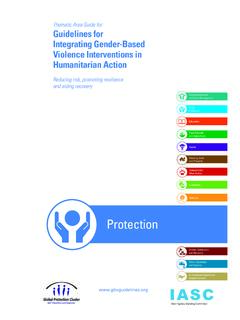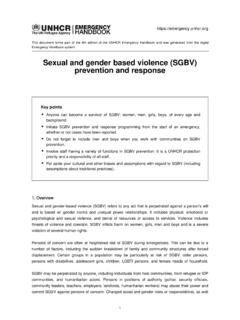Transcription of Guidance on Menstrual Health and Hygiene - UNICEF
1 Guidance on Menstrual Health and HygieneMarch 2019 First editionProgramme Division/WASH3 United Nations PlazaNew York, NY 10017 represent the personal views of the authors and do not necessarily reflect the positions of the United Nations Children s Fund ( UNICEF ). The designations employed in this publication and the presentation of the material do not imply on the part of UNICEF the expression of any opinion whatsoever concerning the legal status of any country or territory, or of its authorities or the delimitations of its by Phil Poirier and designed by Noha HabaiebCover photo credits : UNICEF /UN0145564/SchermbruckerThis Guidance is intended to be updated as new evidence and programme experiences are generated. For more information on this publication or to share your experiences on Menstrual Health and Hygiene , please contact: Lizette Burgers, UNICEF Senior WASH Adviser, Alleman, UNICEF Senior Gender Adviser, Guidance on Menstrual Health and Hygiene4 AcknowledgementsAcronymsKey termsOverviewSection 1: Menstrual Health and Hygiene .
2 A global opportunity An A global UNICEF s commitmentResources for Section 1 Section 2: Programme Programming Supporting government Analysing the Developing a theory of Designing for Building the evidence Assembling a UNICEF teamResources for Section 2 Section 3: Core package of Working through national Building skills and Partnering with A framework for supporting MHHP illar 1: Social supportPillar 2: Knowledge and skillsPillar 3: Facilities and servicesPillar 4: Menstrual materials and suppliesSection 4: MHH for girls and women in vulnerable Reaching girls and women with Responding to humanitarian Transgender and non-binary personsResources for Section 4 Section 5: Learning, monitoring, reporting and A global learning Reporting results within EvaluationResources for Section 5 Annex I: Key informantsAnnex II: Example MHH assessment checklistAnnex III: JMP core questions and indicators for monitoring WASH in schools relevant to MHM4445505459646568717274757880818284868 9 Table 1: Ten critical determinants for assessing bottlenecks and barriers to equitable outcomes for childrenTable 2: Overview of Menstrual materialsTable 3: Sectoral contribution to MHH in emergenciesTable 4: Exemplar topics and research questions around MHM for adolescent girlsTable 5: MHM outcome measures that need standardised definitionsTable 6.
3 MHH in UNICEF s Strategic Plan results framework285970767981 Guidance on Menstrual Health and Hygiene AcknowledgementsThe authors would like to sincerely thank all their key informants for the generosity in sharing their time and knowledge with us during interviews, responding to information and resource requests, and more broadly for their continued partnership with UNICEF on topics related to Menstrual Health and Hygiene . Please refer to Annex I for a list of all contributors. Contributors came from the following organisations and country contexts: Bill and Melinda Gates Foundation The Case for Her Columbia University Global Affairs Canada Johns Hopkins University Save the Children UNFPA UN Girls Education Initiative WaterAid WHO/ UNICEF Joint Monitoring Programme for Drinking Water, Sanitation and Hygiene UNICEF Programme Division (Adolescent Development and Participation, Communication for Development, Disability, Education, Gender, Health , and WASH), Supply Division, Regional Offices (South Asia, Latin America and the Caribbean, Eastern and Southern Africa, West and Central Africa, Middle East and North Africa, and East Asia and the Pacific), and country offices (Indonesia, Ethiopia, Philippines, Bolivia, Zambia, Burkina Faso, and India).
4 The authors would like to similarly extend sincere gratitude to the internal reviewers who provided comments on multiple drafts of this Guidance : J r mie Toubkiss (Evaluation Office); Magdalene Matthews Ofori-kuma (Eastern and Southern Africa Regional Office); Jolly Ann Maulit, Charlotte Pram Nielsen, Yodit Sheido (West and Central Africa Regional Office); Cristina de Carvalho Eriksson, Ayuko Matsuhashi, Tamara Rusinow, Julia Stricker, and Megan Tucker (Programme Division). Special thanks to Frank Odhiambo (Chief of WASH, UNICEF Tanzania) and Esenbek Turusbekov (Climate Change Specialist, UNICEF Kyrgyzstan) for the additional case studies that they contributed during the review period. Thanks to Monica Serrano, knowledge management consultant with Programme Division (WASH) in NY, for her assistance in finalising the Guidance .
5 This Guidance owes a debt of gratitude for the work done by many others, notably the Guidance and manuals already produced by other organisations along with the review and synthesis studies carried out by UNICEF and its partners at the national and regional Guidance was prepared by Leisa Gibson, consultant, and Brooke Yamakoshi, UNICEF WASH Specialist, with contributions and overall Guidance from Lizette Burgers, Senior WASH Adviser, and Patty Alleman, Senior Gender Adviser. 67 AcronymsCSE Comprehensive sexuality education DHS Demographic and Health survey FGD Focus group discussion FGM/C female genital mutilation /cuttingGAP Gender Action PlanJMP WHO/ UNICEF Joint Monitoring Programme for Drinking Water, Sanitation and HygieneMICS Multiple indicator cluster surveyMHM Menstrual Hygiene managementMHH Menstrual Health and hygieneNFI Non-food item WASH Water, sanitation and hygieneWinS WASH in schoolsSRHR Sexual and reproductive Health and rightsTOC Theory of changeUNICEF United Nations Children s FundUNFPA United Nations Population Fund 8 Guidance on Menstrual Health and Hygiene Key termsMenstruation or menses is the natural bodily process of releasing blood and associated matter from the uterus through the vagina as part of the Menstrual is the onset of menstruation.
6 The time when a girl has her first Menstrual Hygiene management (MHM) refers to management of Hygiene associated with the Menstrual process. WHO and UNICEF Joint Monitoring Programme (JMP) for drinking water, sanitation, and Hygiene has used the following definition of MHM: Women and adolescent girls are using a clean Menstrual management material to absorb or collect Menstrual blood, that can be changed in privacy as often as necessary for the duration of a Menstrual period, using soap and water for washing the body as required, and having access to safe and convenient facilities to dispose of used Menstrual management materials. They understand the basic facts linked to the Menstrual cycle and how to manage it with dignity and without discomfort or Health and Hygiene (MHH) encompasses both MHM and the broader systemic factors that link menstruation with Health , well-being, gender equality, education, equity, empowerment, and rights.
7 These systematic factors have been summarised by UNESCO as accurate and timely knowledge, available, safe, and affordable materials, informed and comfortable professionals, referral and access to Health services, sanitation and washing facilities, positive social norms, safe and hygienic disposal and advocacy and menstruator is a person who menstruates and therefore has Menstrual Health and Hygiene needs including girls, women, transgender and non-binary persons. Throughout this Guidance , the term girls and women is used as a shorthand term to increase readability and refers to all menstruators regardless of gender Hygiene materials are the products used to catch Menstrual flow, such as pads, cloths, tampons or supplies are other supportive items needed for MHH, such as body and laundry soap, underwear and pain relief items.
8 Menstrual facilities are those facilities most associated with a safe and dignified menstruation, such as toilets and water refers to the roles, behaviours, activities, and attributes that a given society at a given time considers appropriate for men and women. These attributes, opportunities and relationships are socially constructed and are learned through socialisation processes. They are context- and time-specific, and are changeable. Gender determines what is expected, 1 WHO/ UNICEF (2012) Consultation on draft long list of goal, target and indicator options for future global monitoring of water, sanitation and Hygiene . Available at 9 Key terms2 WHO (2011) Gender mainstreaming for Health managers: a practical approach. Available at 3UN Free & Equal Campaign (2018) Definitions. Available at (2011) Gender mainstreaming for Health managers: a practical approach.
9 Available at and valued in a woman or a man in a given context. In most societies, there are differences and inequalities between women and men in responsibilities assigned, activities undertaken, access to and control over resources, as well as decision-making opportunities. Gender is part of the broader socio-cultural context, as are other important criteria for socio-cultural analysis such as class, race, poverty level, ethnic group, sexual orientation, age, etc2. Transgender (sometimes shortened to trans ) is an umbrella term used to describe a wide range of identities whose appearance and characteristics are perceived as gender atypical including transsexual people and people who identify as third gender. Transgender women identify as women but were classified as males when they were born, transgender men identify as men but were classified female when they were born, while other trans people do not identify with the gender-binary at (biological sex) is defined as the physical and biological characteristics that distinguish males and females, such as reproductive organs, chromosomes and people are born with physical or biological sex characteristics, such as sexual anatomy, reproductive organs, hormonal patterns and/or chromosomal patterns, which do not fit the typical sex definitions of male or female .
10 These characteristics may be apparent at birth or emerge later in life, often at puberty. Intersex people can have any sexual orientation and gender identity. UNICEF /UN0309028/Kokic10 Guidance on Menstrual Health and Hygiene Overview11 OverviewThis Guidance was developed for UNICEF WASH, Education, Health , and Gender specialists or focal points in country offices who are working with their partners to develop programmes related to Menstrual Health and Hygiene (MHH). In recognition of the inherently broad programming considerations of MHH, this Guidance is also aimed at UNICEF colleagues from the cross- cutting clusters of Communications for Development, Adolescent Development and Participation, and Disability. While it is written from the perspective of a UNICEF staff member, it may also be useful for colleagues from other agencies who are working to advance Menstrual Health and Hygiene at a national and sub-national level.











